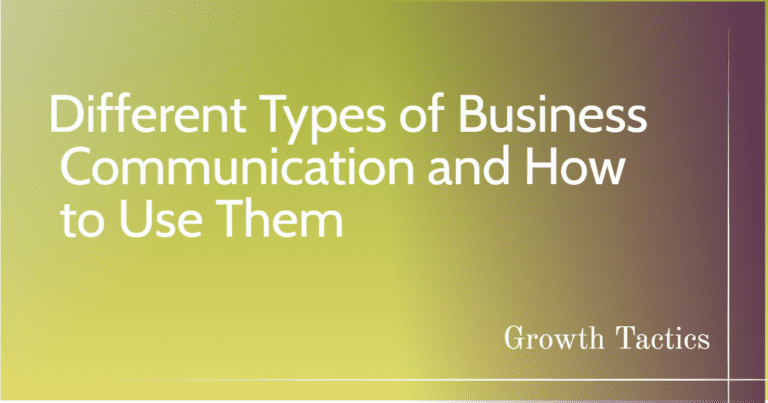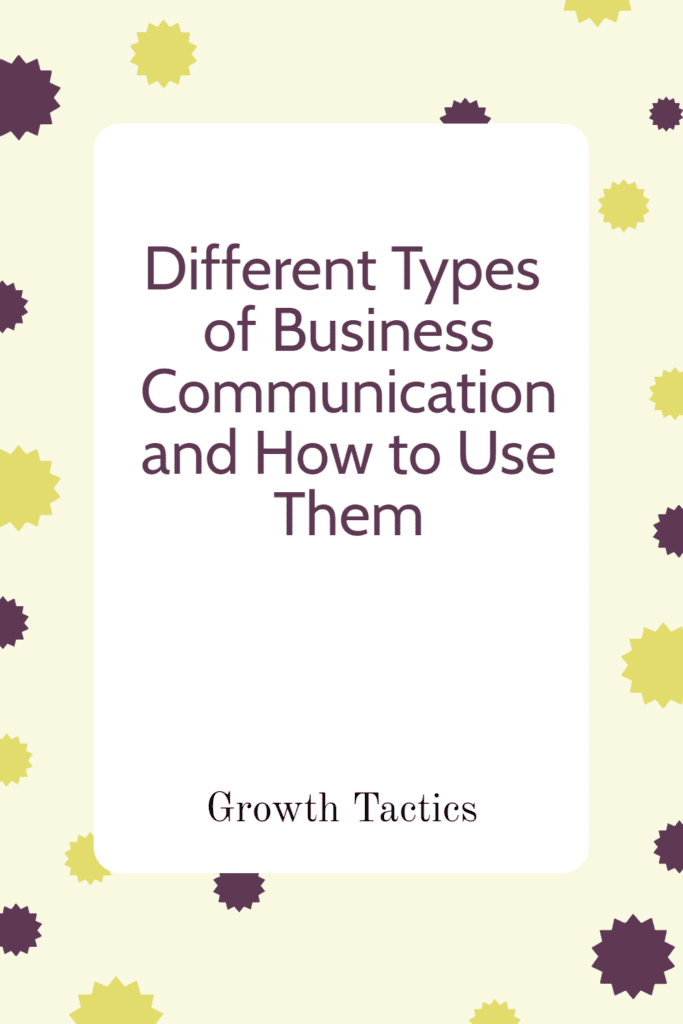In the world of business, effective communication is crucial. It plays a significant role in building strong relationships, boosting productivity, and ensuring the success of a company. There are various types of communication methods that businesses utilize to convey information, ideas, and instructions. In this blog post, we will explore different types of business communication and discuss how to use each effectively.
Jump To Section
Verbal Communication

Definition and Importance
Verbal communication is the act of conveying messages, ideas, and information through spoken words. It is an essential aspect of human interaction and plays a crucial role in various aspects of life, including personal relationships, professional settings, and social interactions.
Verbal communication is important because it enables effective communication and understanding between individuals. Through verbal communication, people can express their thoughts, emotions, and desires, allowing for improved relationships and collaboration.
Types of Verbal Communication
There are several different types of verbal communication, each serving a specific purpose and utilizing different mediums. Here are three common types:
Face-to-Face Communication
Face-to-face communication is perhaps the most basic and common form of verbal communication. It involves direct interaction between individuals, where they can see, hear, and react to each other’s verbal cues and body language. This type of communication allows for immediate feedback, clarity, and a deeper connection between people.
Face-to-face communication is often preferred in situations that require personal connection, such as job interviews, negotiations, and difficult conversations. It provides a chance to read facial expressions, tone of voice, and body language, which enhances understanding and reduces misunderstandings.
Telephone Communication
Telephone communication involves the exchange of information through a telephone conversation. It allows individuals to communicate with each other even when they are physically distant. While it lacks the visual component of face-to-face communication, it compensates by providing immediate and real-time interaction.
Telephone communication is widely used in business settings and personal conversations where immediate response is necessary. It enables individuals to discuss matters efficiently, make quick decisions, and collaborate effectively.
Video Conferencing
Video conferencing combines elements of both face-to-face communication and telephone communication. It allows individuals to communicate and interact with each other in real time, providing both visual and auditory cues.
Video conferencing is particularly valuable in situations where physical distance prevents face-to-face interaction. It offers the convenience of virtual meetings, bringing together individuals from different locations and allowing for more efficient collaboration and decision-making.
Written Communication in Business

Definition and Importance
Written communication refers to the exchange of information, ideas, and messages through written words. It is a significant form of communication that allows individuals to convey thoughts and information with clarity, precision, and permanence. Written communication plays a crucial role in various aspects of life, including business, education, and personal relationships.
Written communication is important because it provides a record of information, making it more reliable and less prone to misinterpretation. It allows individuals to carefully craft their messages, ensuring accuracy and eliminating the potential for misunderstanding. Additionally, written communication enables individuals to communicate across distances and time zones, providing flexibility and convenience.
Types of Written Communication
There are several different types of written communication that individuals use for specific purposes. Here are three common types:
Emails
Emails are a widely used form of written communication in both personal and professional settings. They allow individuals to send messages electronically, instantly reaching the recipient’s inbox. Emails provide a convenient way to communicate, share information, and collaborate with others.
Emails are often used for various purposes, such as sending formal business correspondence, sharing documents, requesting information, or simply maintaining personal communication. They provide a permanent record of communication and allow for easy organization and retrieval of information.
Memorandums
Memorandums, often referred to as memos, are internal documents used within organizations to convey information, make announcements, or discuss specific topics. They are typically short and concise, intended for quick and effective communication.
Memos are commonly used for sharing important updates, outlining procedures, assigning tasks, or requesting input or feedback from colleagues. They are usually shared within the organization and can provide a written trail of communication for future reference.
Reports
Reports are formal documents that provide detailed information, analysis, and recommendations on a particular topic or issue. They are commonly used in business, academic, and scientific settings to summarize research, present findings, and support decision-making.
Reports often follow a specific structure, including an introduction, methodology, results, discussion, and conclusion. They are usually more extensive and require significant research and analysis. Reports provide a comprehensive and organized way to convey complex information and are often shared with a specific audience or stakeholders.
Nonverbal Communication Skills

Definition and Importance
Nonverbal communication refers to the transmission of messages, emotions, and information through nonverbal cues, such as body language, facial expressions, and gestures. It is a powerful form of communication that often complements and reinforces verbal communication. Nonverbal cues can convey emotions, attitudes, and intentions, influencing how messages are interpreted and understood.
Nonverbal communication is important because it adds depth and context to verbal communication, enhancing understanding and establishing rapport. It provides additional cues that help convey meaning and can even contradict or emphasize spoken words. Awareness of nonverbal cues is essential for effective communication, as it allows individuals to interpret messages more accurately and respond appropriately.
Types of Nonverbal Communication
There are various types of nonverbal communication that individuals use to convey meaning and express themselves. Here are three common types:
Body Language
Body language refers to the movements, postures, and gestures individuals use to communicate nonverbally. It includes actions such as crossing arms, leaning forward, nodding, or maintaining eye contact. Body language can convey attitudes, emotions, and intentions, often providing insight into a person’s state of mind or level of engagement.
Body language plays a significant role in interpersonal interactions, presentations, and public speaking. It can indicate interest, confidence, openness, or discomfort. Becoming aware of one’s body language and the body language of others allows for better understanding and effective communication.
Facial Expressions
Facial expressions are an important aspect of nonverbal communication, as the face can display a wide range of emotions. Smiling, frowning, raising eyebrows, and narrowing eyes are just a few examples of how facial expressions convey feelings and attitudes. Facial expressions are often universal, allowing for cross-cultural understanding.
Facial expressions can enhance or reinforce verbal messages. A smiling face can indicate friendliness, while a furrowed brow can indicate confusion or concern. Understanding and being mindful of facial expressions can contribute to more effective communication and better connection with others.
Gestures
Gestures are deliberate hand or body movements that accompany verbal communication. They can convey meaning, emphasize points, or enhance understanding. Common gestures include pointing, thumbs up, waving, or shaking hands.
Gestures can vary across cultures and contexts, so it’s important to be mindful of cultural differences when using or interpreting them. Gestures can add clarity and significance to verbal messages, helping convey intentions and emotions in a way that words alone cannot.
Internal Communication

Definition and Importance
Internal communication refers to the exchange of information, ideas, and messages within an organization. It involves communication between individuals at various levels and departments, fostering collaboration, coordination, and alignment toward organizational goals. Effective internal communication is crucial for enhancing employee engagement, productivity, and overall organizational success.
Internal communication is important because it enables the smooth flow of information, ensuring that employees are well-informed, motivated, and connected. It helps build a positive work culture, fosters transparency, and strengthens relationships among team members. Effective internal communication enhances teamwork, innovation, and the overall functioning of the organization.
Types of Internal Communication
Several types of internal communication serve different purposes within an organization. Here are three common types:
Upward Communication
Upward communication refers to the flow of information from lower-level employees to higher-level managers or executives. It enables employees to provide feedback, share ideas, express concerns, and report progress to their superiors. Upward communication empowers employees by giving them a voice and helps leaders gather insights and make informed decisions.
Upward communication can be facilitated through channels such as performance reviews, suggestion boxes, surveys, or regular meetings. Creating a supportive and open environment where employees feel comfortable sharing their thoughts and ideas is essential for effective upward communication.
Downward Communication
Downward communication involves the transmission of information from higher-level managers or executives to lower-level employees. It includes sharing company goals, providing instructions, giving performance feedback, and delivering announcements or updates. Downward communication helps align employees with the organization’s mission and objectives, provides clarity, and ensures everyone is on the same page.
Downward communication can be facilitated through channels, such as team meetings, email updates, newsletters, or company-wide announcements. ILeaders need to communicate, provide context, and actively engage with employees to ensure effective downward communication.
Lateral Communication
Lateral communication refers to the exchange of information among employees at the same organizational level or across departments. It enables collaboration, sharing of knowledge, and coordination of tasks between individuals or teams. Lateral communication fosters teamwork, innovation, and problem-solving by allowing employees to share expertise, seek advice, and collaborate on projects.
Lateral communication can take place through various channels, such as team meetings, instant messaging platforms, collaborative tools, or cross-functional projects. Encouraging a culture of open communication, building relationships across departments, and providing opportunities for cross-functional collaboration are important for promoting effective lateral communication.
External Communication

Definition and Importance
External communication refers to the exchange of information, messages, and interactions between an organization and individuals or entities outside of the organization. It encompasses communication with customers, suppliers, stakeholders, and the general public. Effective external communication is crucial for building and maintaining relationships, promoting the organization’s brand and reputation, and achieving business objectives.
External communication plays a vital role in shaping customers’ perceptions of a company and its products or services. It establishes and maintains relationships with suppliers, enables effective stakeholder engagement, and establishes the organization’s public image. By effectively communicating with external entities, organizations can enhance customer satisfaction, attract new business opportunities, and build a positive reputation in the marketplace.
Types of External Communication
There are various types of external communication that organizations engage in to interact with external stakeholders. Here are three common types:
Customer Communication
Customer communication refers to the interaction between an organization and its customers or clients. It includes various channels, such as email, phone calls, social media, or face-to-face interactions. Customer communication aims to provide information, address inquiries or concerns, and build strong relationships with customers.
Effective customer communication is essential for understanding customer needs, delivering exceptional customer service, and fostering customer loyalty. It involves active listening, empathy, and timely response to customer inquiries or feedback. By engaging in effective customer communication, organizations can enhance customer satisfaction, increase customer loyalty, and drive business growth.
Supplier Communication
Supplier communication involves the exchange of information and interactions between an organization and its suppliers or vendors. It includes areas such as order placement, managing delivery schedules, negotiating terms and agreements, and resolving any supply chain issues. Effective supplier communication ensures a smooth and efficient supply chain, leading to timely delivery of goods or services.
Establishing clear channels of communication with suppliers helps maintain strong supplier relationships, ensures transparency, and enables effective collaboration. Good supplier communication facilitates efficient procurement, reduces delays or disruptions, and improves overall business operations.
Public Relations
Public relations (PR) communication focuses on managing the organization’s relationship with the public and media. It involves activities such as press releases, media interviews, social media management, and organizing events or sponsorships. Public relations communication aims to shape public perception, build brand reputation, and communicate organizational messages to the broader public.
Effective PR communication involves crafting compelling narratives, maintaining consistent messaging, and engaging with media or influencers. It helps organizations build brand awareness, manage crises or reputational issues, and establish trust with the public. Strong public relations can positively impact an organization’s image, generate media coverage, and enhance credibility.
Wrapping up the Different Types of Business Communication
As business leaders, the art of communication is one we must continuously refine. By mastering the various types of business communication, you can build stronger relationships, negotiate with finesse, and propel your career or business to new heights.
So, embrace the power of formal and informal communication, polish your verbal and written skills, harness the potential of nonverbal cues, and leverage digital tools. Remember, effective communication is a two-way street – listen actively, adapt to your audience, and choose the appropriate method.
Now, go forth, communicate with clarity and confidence, and watch as your business ventures thrive!


